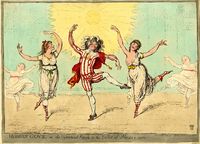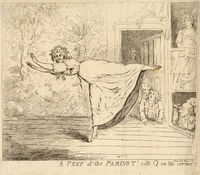Annotation:Madam Parisott's Hornpipe
Back to Madam Parisott's Hornpipe
MADAM PARISOTT'S HORNPIPE. AKA and see "Parasott Hornpipe," "Parisott's," "Whiskey Barrel." English, American; Hornpipe. The hornpipe was printed by London dancing master Thomas Wilson in his 1816 collection A Companion to the Ball Room as "Parisot's Hornpipe," and, in America, in the 1817 collection of New York flute player and music seller Edward Riley as "Madam Parisott's Hornpipe." The slightly skewed title "Madam Parisol's Hornpipe" is the heading for the tune in Utica, New York, publisher William Williams' A New and Complete Preceptor for the Fife (1819). The melody appears under the title "Whiskey Barrel" in George P. Knauff's Virginia Reels, volume I (Baltimore, 1839).
Mademoiselle Parisot [1] (c. 1775 – after 1837) was a famous stage dancer and opera singer of the late 18th and early 19th century. She was a thin, elegant dancer who always smiled. In the first chapter of William Makepeace Thackeray's Vanity Fair, he writes:

For she could not only sing like a lark, or a Mrs. Billington, and dance like Hillisberg or Parisot, and embroider beautifully, and spell as well as a Dixonary itself, but she had such a kindly, smiling, tender, gentle, generous heart of her own, as won the love of everybody who came near her...

She was famous, or infamous, for her provocative costumes, dancing in neo-classical garb that often left one breast exposed. She also lifted her legs higher than was usual for a dancer, which was much parodied in period caricatures.
Source for notated version: Riley (Flute Melodies, vol. 2), 1817; p. 73.
Printed sources:
Recorded sources:
Back to Madam Parisott's Hornpipe
